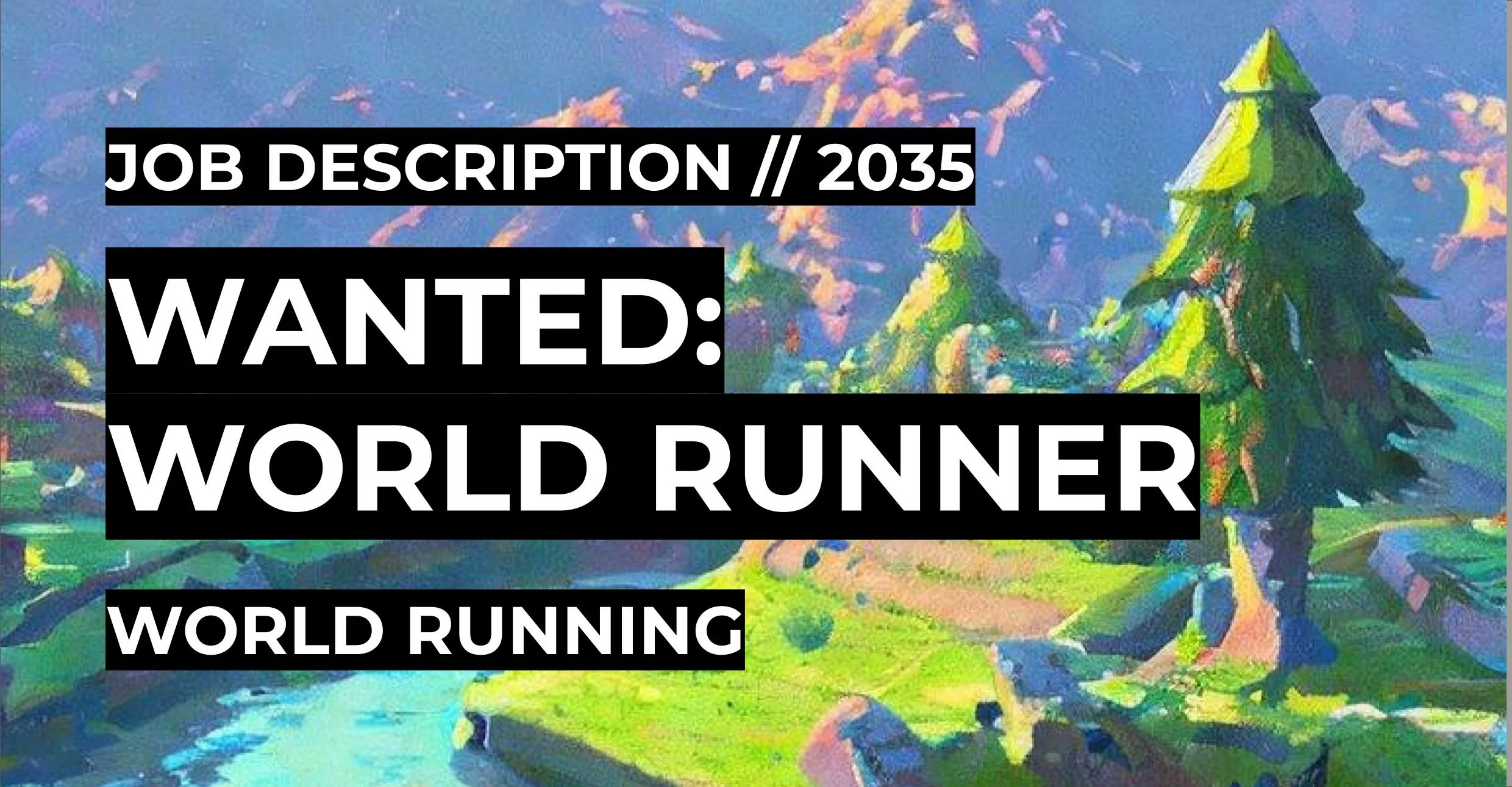One of the things about hanging out in the relentlessly enthusiastic Near Future Lab Discord is that it inspires one to ‘commit a design fiction‘ for themselves.
Julian wrote in his OG 2009 design fiction essay that: “Design fiction objects are totems through which a larger story can be told, or imagined or expressed. They are like artefacts from someplace else, telling stories about other worlds”
I recently wrote some job descriptions for a client who is looking to build a team around them. Despite our knowing the roles and responsibilities; workshopping *exactly* what the roles looked like on the day-to-day revealed a great deal more about the wider project than I would have expected.
Job descriptions are by their very nature speculative design fictions. Diegetic objects from both the ‘world’ of work and the near future where the job actually exists.
Realising this got me thinking….
One of the questions in my worldrunning.guide book is What is a World Runner?
I recently travelled to the near future in a janky time machine in an attempt to find out.
Unfortunately all I could grab was a PDF of the job description below. Reading it though wide-eyes back in relative safety of 2023, it tells a much larger story about the future of IP, worlds, the metaverse and (in this incarnation) the role of a World Runner.
World Runner Job Description 2035
If the embedded PDF isn’t loading click here
World Runner Glossary
I made up a bunch of plausible words/terms whilst writing this JD. When sprinkled in amongst current metaverse buzzwords, they add quite a bit of flavour to the document.
I asked for some feedback from friends after the draft and a leading AR storytelling theorist wrote the following:
I was actually disappointed (but also kind of relieved) when I realised you probably imagined an expanded futuristic version of “UFE (Universal Front End) Systems”. Disappointed that there wasn’t already some kind of universal front end for crossplatform worldbuilding… and relieved that I wasn’t just ignorant of the existence of such an initiative.
Below are some general definitions for some terms I used in the Job description which are in themselves interesting jumping off points for future exploration:
Sentience Ethologist: An expert in the study and understanding of sentient beings’ behaviours, emotions, and interactions within the world environment, including AI, human, and hybrid intelligences.
Dynamics Analyst: A specialist responsible for monitoring, analysing, and optimising the various systemic elements and relationships within the world, ensuring balance, coherence, and progression.
World Browser: Similar to web browsers of the past, a World Browser allows users to access, explore, and engage with the metaverse across various mediums and devices.
Universal Front End (UFE) Technologies: A collection of principles, tools, and methods designed to create seamless, adaptable, and responsive user interfaces, ensuring consistency when connecting to different world engines.
Exo-Economies: External economic systems and marketplaces that interface with and impact the world’s virtual economy, including digital currencies, decentralised exchanges, and cross-world commerce.
Metascape Gardener: A term describing the World Runner’s role in using AI-driven worldbuilding tools to cultivate, prune, and adapt procedurally generated narrative content, ensuring coherence and alignment with the overall world vision.
Worldwalkers: Users who actively participate in and navigate the world, engaging with its stories, characters, and systems, shaping the narrative and experience through their choices and actions.
Permissive Protocol: Encompassing various innovative legal arrangements, systems, and rules for managing a world’s intellectual property, the Permissive Protocol is held in common by the world and its participants.
Super Story: The long-term, overarching narrative that incorporates the best aspects of all worlds, resulting in a cohesive and engaging experience of lore for worldwalkers.
Agent-Based Sentient Storycraft: A narrative design approach that focuses on understanding and considering the emotions, desires, and motivations of sentient beings (worldwalkers, characters, and AI) within the world, shaping the story and interactions accordingly.
Data Ocean: A vast collection of data offered or sold by individuals. Gathered from various sources, including wearables, AI sentiment analysis, and other companion data, used to inform and improve the world’s development.
Adaptive Agent Companion Data: Information collected from individuals AI companions that learn, adapt, and interact with individuals and the world around them. Providing insights into user preferences, behaviours, and desires to enhance the overall experience.
Community Narrative Investment Committee: A group of representatives from the worlds community responsible for evaluating and making decisions on proposals, initiatives, and developments within the world, ensuring alignment with the collective vision and values.
Chrono-warp Narrative Constructure: Who knows what this means. Sounds rad tho.
Thanks to Ben, Rob, Julian, David and Alex!

Permanently Moved
Permanently Moved (dot) Online is a weekly podcast 301 seconds in length; written, recorded and edited by @thejaymo

Leave a Reply